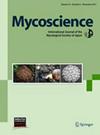石氏伤寒复合体的分类学修订。
IF 1.4
4区 生物学
Q4 MYCOLOGY
引用次数: 3
摘要
根据形态和生理特征、DNA序列和交配反应,将石kariensis及其相关真菌划分为3个生物种。我们认为石kariensis复合体可分为3个种(T. ishikariensis、T. canadensis和T. hyperborea)和2个变种(T. ishikariensis var. ishikariensis和var. idahoensis)。对大北伤寒进行了重新评价,认为它也是石kariensis复合体的一个独立种。本文章由计算机程序翻译,如有差异,请以英文原文为准。
Taxonomic revision of the Typhula ishikariensis complex.
Typhula ishikariensis and the related fungi were separated into three biological species by morphological and physiological characteristics, as well as DNA sequences and mating reactions. We propose that the T. ishikariensis complex should be divided into three species (T. ishikariensis, T. canadensis and T. hyperborea) and two varieties (T. ishikariensis var. ishikariensis and var. idahoensis). Typhula hyperborea was reappraised to be recognized also as a separate species of the T. ishikariensis complex.
求助全文
通过发布文献求助,成功后即可免费获取论文全文。
去求助
来源期刊

Mycoscience
MYCOLOGY-
CiteScore
3.00
自引率
7.10%
发文量
32
审稿时长
3 months
期刊介绍:
Mycoscience is the official English-language journal of the Mycological Society of Japan and is issued bimonthly. Mycoscience publishes original research articles and reviews on various topics related to fungi including yeasts and other organisms that have traditionally been studied by mycologists. The research areas covered by Mycoscience extend from such purely scientific fields as systematics, evolution, phylogeny, morphology, ecology, physiology, biochemistry, genetics, and molecular biology, to agricultural, medical, and industrial applications. New and improved applications of well-established mycological techniques and methods are also covered.
 求助内容:
求助内容: 应助结果提醒方式:
应助结果提醒方式:


